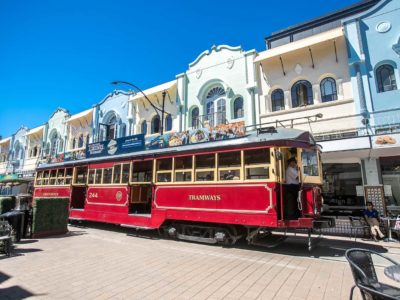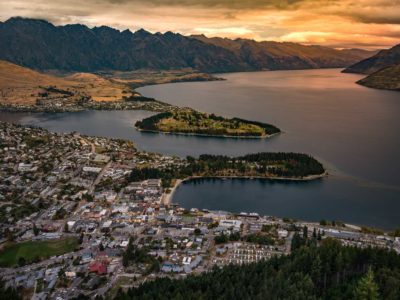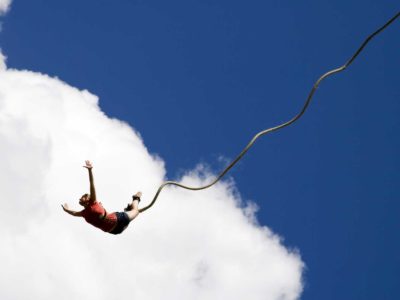New Zealand really does conjure up images of Middle Earth.
It is a land filled with breathtaking scenery, striking mountains, pristine beaches, lush forests and rolling hills.
The landscape is so diverse in such a small space.
One minute you can be walking on a glacier and the next you can be hiking beside a waterfall. It is simply an unforgettable journey.
This New Zealand travel guide will help you plan your next vacation.
Table of contents
Table of Contents
Fast Facts about New Zealand
- New Zealand power voltage is 220 V 50Hz; Plug I
- The currency is the New Zealand Dollar and is around 1.20 NZD to 1.35 USD
- Internet can be slow and expensive, travelers can check out McDonalds and libraries for free Wi-Fi.
- Tipping is not customary in New Zealand, so you don’t need to leave anything extra unless the service was truly exemplary.
- You can get a local sim card from Vodaphone once you arrive in New Zealand. We recommend this for longer stays.
Things to See and Do in New Zealand
- Sky Dive Abel Tasman – enjoy the outstanding scenery as you jump from the 16,500 feet.
- Whitewater Raft Class 5 Rapids – go on the ultimate white water rafting experience through freezing glacial waters and the ultimate class 5 rapids.
- Swim with Dolphins – have a special and personal moment with a dolphin in the Bay of Islands.
- Paraglide in Queenstown – take a tandem jump and fly high in the sky overlooking the city, lake and mountains.
- Bungy Jump! – try a bungy jump (yes it’s spelled bungy, not bungee) in New Zealand, the land where it was invented.
- Take a Sailing Adventure – through Abel Tasman
- Tamaki Maori Village – Rotorua is renowned for its Maori culture experiences and the most well-known of them all is the Tamaki Maori Village Rotorua where travelers can experience a journey into the heart of the Maori culture.
- Visit the Boiling crater of Wai-O-Tapu – also known as the Campagne pool, this geothermal area is filled with thermal springs and geysers
- Trek the Fox Glacier – suit up with thick woolly socks and boots before embarking on a full day walk through this epic glacier.
- Discover the Glow-worm Caves – be dazzled by the sparkling display of bioluminescent lights in this cave.
- Check out the Sights of Middle Earth – take a tour with Luxmore Jet for a pinch of adrenaline with a heap of nature through Middle Earth.
New Zealand Travel Guides
Budgeting
Accommodation
Budget: New Zealand has a variety of hostels for about 15.5-30 New Zealand dollars per night. These hostels come with dorms, free Wi-Fi, shared kitchens, lounge areas, and great central locations.
Mid-Range: Mid-range hotels will cost around 86-150 New Zealand dollars per night. Amenities include private rooms with coffee makers and flat-screen TVs, a hotel restaurant and bar, a gym, and an indoor pool.
High-End: For five-star hotels, expect to pay around 156-400 New Zealand dollars per night. Take in the best with top-of-the-line hospitality, private rooms and suites with balconies and living rooms, fine dining options with live music, a spa and hot tub, a fitness center, in-room breakfast, and room service.
- Check out our favorite booking platforms Booking.com, Tripadvisor and VRBO for the best deals on accommodation.
Food
The cuisine in New Zealand favors seafood, roast lamb, fish and chips, wine, and cheese. Dinner is usually the main meal of the day. When out and about, look for hokey pokey ice cream (caramelized honeycomb) or pavlova (meringue, fruit, and whipped cream).
New Zealand has many street vendors, as well as restaurants, where you can try more of their cuisine. In total, expect to pay around 75 New Zealand dollars per day for food when dining at restaurants.
The Best Ways to Get Around New Zealand
Getting to New Zealand:
Flights: The main hubs to New Zealand are Auckland, Christchurch, Wellington, and Queenstown. Auckland Airport is the largest international airport in New Zealand and is located about 9.5 miles from downtown.
Other major airports include Christchurch International Airport (7.5 miles from the city) and Wellington International Airport (3.5 miles from the city). Air New Zealand flies from around the world with direct flights from cities such as Vancouver, San Francisco and Hong Kong.
You can check for the best flights to New Zealand on Skyscanner.
Transportation:
Buses: Buses are a good way to get around and one of the main ways that locals travel. Tickets start at 1.57 New Zealand Dollars. If you know you’ll use the bus a lot, consider getting a bus pass, with prices based on the number of trips you take. You can also look for bus tours that travel throughout the whole of New Zealand and include meals and places to sleep.
Taxis: Taxis are available in most cities in New Zealand and start at 3.50 New Zealand dollars in places like Auckland.
Campervans are an excellent way to get around New Zealand with several companies offering rentals and well-established campgrounds with full facilities. Read all about our experience here.
To rent a car, you must be at least 21 years old and have a driver’s license. Drivers under 25 will be subject to additional fees per day. For drivers 25 and over, prices start at 70 New Zealand dollars per day. Check for prices and availability here.
Uber: Uber is available throughout New Zealand.
When to go To New Zealand
New Zealand has a varied landscape with two distinct islands. The North Island is warmer than the South with a sub-tropical climate.
Snorkeling and swimming is more pleasant up here. But the South Island was made for adventure.
Dec-Feb is summer in New Zealand – this is high season with the most visitors. You’ll see a lot of campervans on the road and campgrounds fill up quickly.
March – April – a great time to visit at just the start of autumn. There are still warm days and crowds start to thin out. But pack layers and a jacket. You’ll start to see the fall colours too! We travelled through New Zealand all of March and days were warm. Evenings were cool, but we still managed to snorkel, go sailing, skydive, bungy jump…we did everything you would do in New Zealand during the summer months.
June – August is winter in New Zealand. If you are into skiing, you may want to check out New Zealand in the winter. The South Island can dip below -10 C
– the North Island sees more rain in winter
-Snowfalls happen in the Central Plateau on the North Island and the Southern Alps in the South.
Sept- Nov – Good shoulder season for travel as things start to warm up and crowds haven’t arrived full swing.
Where to Stay in New Zealand
Sofitel Auckland – centrally located in Auckland at Viaduct Harbour, you can’t go wrong with a Sofitel. It is close enough to amenities, but quiet enough for a retreat.
ibis Wellington: Just a few minutes from the museum, city gallery, and library, there is plenty to do around this hotel in Wellington. Once you’re done exploring, come back to the hotel for flat-screen TVs and tea inside your room, a lobby bar, a fitness center, and a breakfast buffet.
BreakFree on Cashel: Just a short walk to Canterbury Museum, North Hagley Park, and Cathedral Square, stay in the heart of the central business center in Christchurch. The hotel comes with rooms with city views, family rooms with bunk beds, a restaurant and bar, room service, and an airport shuttle.
Check out our favorite booking platforms Booking.com, Tripadvisor and VRBO for the best deals on accommodation.
What to Pack for New Zealand
New Zealand has a diverse landscape with volcanoes, glaciers, breathtaking mountains, endless stretches of beaches and luscious forests. New Zealand’s climate varies depending on the area travelers intend to visit.
The weather in New Zealand can change in an instant, so travelers should always be prepared for anything!
- Layers – The general rule of thumb is to pack at least four layers: a base layer, long sleeve shirts, a fleece (mid-layer) and a top layer such as a windbreaker (waterproof!). Don’t forget a warm pair of gloves, thick scarf and a hat!
- Read our tips for layering and check out our ultimate list of travel gear.
- Thermal underwear – this is especially important if traveling to the South during the winter or hiking in the mountains.
- Sunscreen – The depleted ozone layer over the country means that the sun is incredibly strong. Along with sunscreen, pack a pair of sunglasses and a hat.
- Rain Gear – it tends to rain a lot in New Zealand even in the summer. However, avoid bringing along umbrellas as the rain is coupled with strong gusts of wind. Instead, invest in a good waterproof jacket that will keep you protected.
- Backpacks – a sturdy backpack or large bag is more appropriate for adventuring as they are easier to carry and you don’t have to roll them through the sand of New Zealand’s amazing beaches.
New Zealand Travel Guide: Best Booking Resources
Whenever we travel to we make sure to start with these companies. We have tried a lot of different ones over the years and all of these have consistently proven to be the best when it comes to offering great prices.
We have used every one of these personally and continue to do so.
- Booking.com: This is our go site to when comparing prices for accommodation. It usually has the cheapest prices, especially in Europe and we love their interface. Not to mention you get free cancellation and you are guaranteed the best price.
- Trip Advisor: What we like about Trip Advisor is that we can look at all the reviews and then book our accommodation. TripAdvisor is where we go when we want to compare prices with multiple accommodation providers.
- VRBO: is the main search engine we use when we are looking for a home or apartment rental. It can sometimes be cheaper than hotels and it is the best way to stay in areas that offer a more local feel.
- Hostelworld: With one of the largest databases of hostels in the world, Hostelworld is the go-to site when you are looking for budget accommodation.
- Skyscanner: This is the first place we check for flights. It consistently comes back with the cheapest and best options. It allows us to compare a lot of airlines to get the best price.
- Rome 2 Rio: If you want to see how to get somewhere by plane, train, bus, ferry or car Rome2Rio lays it all out for you as well as related costs.I love how they show it all to you on a Google Map and it works offline.
- Get Your Guide: For all your day trip and city guide needs, we use Get Your Guide. It has the world’s largest collection of things to do with more than 30,000 activities in 7500 destinations.
- World Nomads Insurance: When traveling to Italy you should always have travel insurance. We have found the best bang for your buck is by far World Nomads.
New Zealand Travel Guide: Related Articles
To browse all our articles and guides about New Zealand click here.




